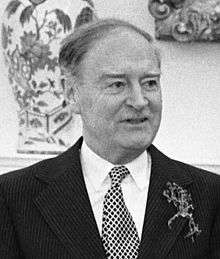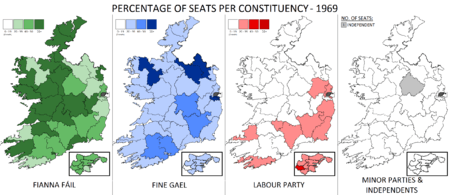Irish general election, 1969
| | |||||||||||||||||||||||||||||||||||||||||||||||||||||||||||||||
| |||||||||||||||||||||||||||||||||||||||||||||||||||||||||||||||
| |||||||||||||||||||||||||||||||||||||||||||||||||||||||||||||||
|
| |||||||||||||||||||||||||||||||||||||||||||||||||||||||||||||||
| Percentage of seats gained by each of the three major parties, and number of seats gained by smaller parties and independents. | |||||||||||||||||||||||||||||||||||||||||||||||||||||||||||||||
| |||||||||||||||||||||||||||||||||||||||||||||||||||||||||||||||
The Irish general election of 1969 was held on 18 June 1969. The newly elected members of the 19th Dáil assembled at Leinster House on 2 July when the new Taoiseach and government were appointed. The general election took place in 42 parliamentary constituencies throughout Ireland for 144 seats in the lower house of parliament, Dáil Éireann.
Campaign
The general election of 1969 saw two new leaders of the two main parties fight their first general election. Jack Lynch of Fianna Fáil had become Taoiseach in 1966 and was attempting to win his first election. Liam Cosgrave had taken charge of Fine Gael in 1965 and was now leading his party into his first election. Brendan Corish was fighting his third general election as leader of the Labour Party.[1]
Fianna Fáil had been in power since 1957, and in spite of media predictions the party was still very popular with the voters. Its leader Jack Lynch proved to be the party's biggest electoral asset. His quiet, easy-going and reassuring style, coupled with the catchy slogan "Let's back Jack!", attracted many new voters to Fianna Fáil. The party had introduced many innovative pieces of legislation during the 1960s and was now looking for a fresh mandate. Fianna Fáil were also helped by a deeply divided opposition.
Fine Gael had internal divisions. There was tension between the older conservative members, who wanted to keep the party as it was, and the younger deputies who wanted to move the party to the left. One of the party's policies proposed to abolish compulsory Irish for State examinations and civil service jobs.
The Labour Party on the other hand were predicted to make massive gains after firmly ruling out a pre-election pact with Fine Gael. The party fielded a number of new, high-profile candidates, including Justin Keating, Conor Cruise O'Brien, David Thornley and Noël Browne.[1] The slogan "The Seventies will be Socialist" was popular with Labour supporters; however, Fianna Fáil played the "red card", linking the Labour Party with communism. The tactic worked successfully.
Result
| Party | Leader | Seats | ± | % of seats |
First Pref votes |
% FPv | ±% | |
|---|---|---|---|---|---|---|---|---|
| Fianna Fáil | Jack Lynch | 75 | +3 | 52.1 | 602,234 | 45.7 | –2.0 | |
| Fine Gael | Liam Cosgrave | 50 | +3 | 34.7 | 449,749 | 34.1 | 0 | |
| Labour Party | Brendan Corish | 18 | –4 | 12.5 | 224,498 | 17.0 | +1.6 | |
| Irish Workers' Party | Michael O'Riordan | 0 | 0 | 0 | 242 | 0.0 | 0 | |
| Independent | N/A | 1 | –1 | 0.7 | 42,230 | 3.2 | +1.1 | |
| Spoilt votes | 16,010 | — | — | |||||
| Total | 144 | 0 | 100 | 1,334,963 | 100 | — | ||
| Electorate/Turnout | 1,735,388 | 76.9% | — | |||||
- Fianna Fáil majority government formed.
The result marked a third successive victory for Fianna Fáil, led by Jack Lynch. Fianna Fáil and Fine Gael each lost votes, yet gained seats. Labour gained votes, yet lost seats. It was the last re-election of an Irish government for twenty years—and even in the 1989 general election, Fianna Fáil was only re-elected with a minority in Dáil Éireann.
First time TDs
A total of 37 TDs were elected for the first time:
- Peter Barry
- Michael Begley
- Seán Brosnan
- John Bruton
- Liam Burke
- Richard Burke
- Hugh Byrne
- Edward Collins
- John Conlan
- Ger Connolly
- Gerard Cott
- Bernard Cowen
- Kieran Crotty
- Conor Cruise O'Brien
- Noel Davern
- Barry Desmond
- Tom Enright
- Martin Finn
- Garret FitzGerald
- Paddy Forde
- Billy Fox
- Michael Herbert
- Thomas Hussey
- Liam Kavanagh
- Justin Keating
- Bill Loughnane
- Gerard Lynch
- Ray MacSharry
- Tom McEllistrim
- Michael J. Noonan
- Michael O'Kennedy
- John O'Sullivan
- Paddy Power
- Michael Smith
- Frank Taylor
- David Thornley
- Jim Tunney
Re-elected TDs
Outgoing TDs
- Lionel Booth (Retired)
- Paddy Clohessy (Retired)
- Seán Collins (Lost seat)
- John A. Costello (Retired)
- Edward Cotter (Retired)
- James Dillon (Retired)
- Nicholas Egan (Retired)
- John Fanning (Retired)
- Denis Larkin (Retired)
- Seán Lemass (Retired)
- Patrick McAuliffe (Lost seat)
- Seán MacEntee (Retired)
- Michael O'Higgins (Lost seat)
- Patrick Tierney (Retired)
By-elections
See also
References
- 1 2 Kagachi, Chihiro (2002). History of Irish Politics. pp. 133–134.
- ↑ "19th Dáil 1969 General Election". ElectionsIreland.org. Retrieved 12 June 2009.
- ↑ "Dáil elections since 1918". ARK Northern Ireland. Retrieved 12 June 2009.
- ↑ Nohlen, D & Stöver, P (2010) Elections in Europe: A data handbook, pp1009-1017 ISBN 978-3-8329-5609-7
.jpg)

